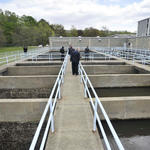| |
| |
|
The 411 for Water Treatment Professionals
|
|
|
|
|
| |
| |
| |
|
City Says Change in Water Treatment Will Help Battle Lead in Water
|

The city will spend $15.6 million to change how it controls corrosion in its water system as a way to prevent lead pipes from deteriorating and sending lead into residents’ drinking water. The city will use soda ash at its water treatment plant instead of lime to cut the corrosiveness of the water, which should bring the treatment operations into compliance.
|
|
| |
|
|
| |
| |
| |
|
Reusing Water Surfaced During Oil Production Topic of Industry Conference
|
That water may be returned into the earth, put into a pit for reuse or treated. The latter is the conference’s main focus. “You can treat the water,” Samuels said. “And what I mean by that is, introduce other chemicals that will reduce that bacteria and reduce some of the chemicals that are in the water that came out of the ground.
|
|
| |
|
|
| |
| |
| |
|
The Role of Artificial Intelligence in Surface Water Treatment
|
Artificial Intelligence (AI) is increasingly becoming a game-changer in various sectors, and the water treatment industry is no exception. In recent years, the role of AI in enhancing surface water treatment techniques has been significantly impactful, bringing about innovative solutions to address water scarcity and pollution challenges.
|
|
| |
|
|
| |
| |
| |
|
Even Treated Wastewater Affects Our Rivers
|
Effluents from wastewater treatment plants have a dual effect: Some species disappear, while others benefit. Especially certain insect orders, such as stonefly and caddisfly larvae, are decimated. Certain worms and crustaceans, by contrast, can increase in number. A team from Goethe University Frankfurt led by Daniel Enns and Dr. Jonas Jourdan has corroborated this in a comprehensive study.
|
|
| |
|
|
| |
|
|